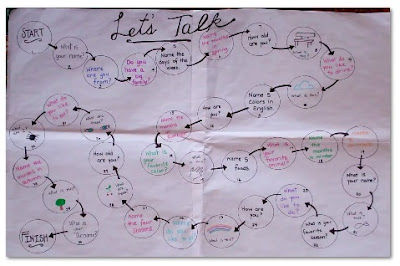Further Thoughts
on Reusing and Stock Supplies
Even if students have seen the same flashcards or visuals in
the past, there are multiple ways to use them again and keep visuals
interesting.
For example, I have a stock set of people that I use for
many different things:
1.
They are used to describe the family and
relationships within the family.
They work well with a Family Tree activity:
 |
| Blank Family Tree (Template) |
 |
| Family Tree with members put in place |
2.
I use them to study location and prepositions, too.
For example:
 |
Where is he?
He is at the sports-ground.
|
 |
Where is she?
She is at school. |
 |
Where are they?
The are at the cafe. |
3.
I use them to have students describe physical
attributes when they are learning adjectives.
With proper care and storage, you can preserve your work to use many times over in many different activities; this works well for other types of supplies, too, like board games, card games, quizzes, grouping strategies and dialogues.
Happy Teaching!
















